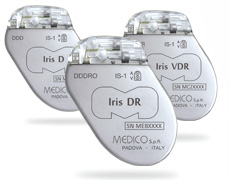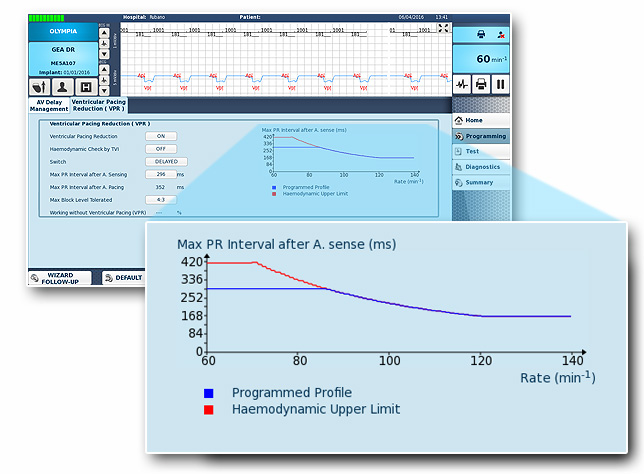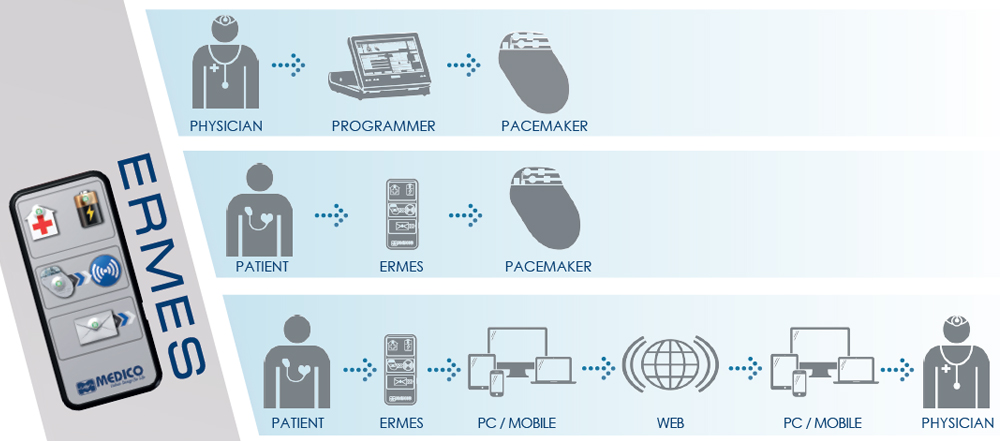
Iris DR (DDDR)






Iris D (DDD)





Iris VDR (VDDR)






Advanced dual-chamber pacingwith the support of remote control
Learn more about:
![]() Mobile remote monitoring |
Mobile remote monitoring | ![]() Single Lead VDD Pacing
Single Lead VDD Pacing
Diagnostic evaluation of tachycardia episodes based on an innovative electrogram ( iECG )
The iECG completes the set of electrograms recorded in the IRIS family: the band-pass filtered atrial and ventricular EGMs (supporting the pacemaker sensing function) and the corresponding wide-band EGMs, which allow a first step evaluation of signal morphology and duration. The iECG further improves this feature, providing a tracing similar to a surface ECG lead, with better visualization of the atrial activity.
It is automatically recorded in the event of tachycardia (optionally complemented by the TVI tracing) to discriminate ventricular and supraventricular tachyarrhythmias, haemodynamically tolerated or not.

The iECG ventricular complex morphology is unchanged in SVTs. TVI fluctuation shows reduced amplitude, but is regularly present at every beat.

The iECG ventricular complex morphology is radically changed in VTs. The example shows a non-tolerated, spontaneously terminated VT. TVI fluctuation is abolished in the absence of ejection and is detected again as soon as sinus rhythm is reestablished.
Ventricular pacing reduction (VPR) with full respect of the haemodynamic constraints
The pacemakers of the IRIS family are designed to keep the incidence of ventricular pacing at the lowest possible limit still compatible with the haemodynamic efficiency.
The stimulation could be avoided also on 2nd degree blocks which maintain the conduction ratio within the programmed limit value.

The upper limit of the accepted PR is automatically adjusted to the cardiac rate to prevent atrial systole against closed valves.
Haemodynamic surveillance and monitoring of ventricular mechanics by Transvalvular Impedance assessment (TVI)
In the IRIS family, the electrodes used for current injection and related voltage measurement are set independently.
This way, ventricular motility can be assessed in different areas, to improve the characterization of ventricular mechanics and extend the diagnostic power of TVI evaluation.
In the absence of external programming at 3 months from implantation, the system automatically selects the TVI configuration providing the most suitable signal.
In the event of a tachycardia, the TVI tracing can compared with the basal signal, to gain information on the haemodynamic impact of the arrhythmia.
A TVI waveform change in the long term is a useful sign to select patients where a check of the haemodynamic function with conventional methods is advisable.
Autoregulation of atrial and ventricular sensitivity
Atrial and ventricular sensitivity is automatically adjusted to the intrinsic signal amplitude.
The algorithm has been studied to provide a safety margin of at least 3X.
The atrial sensitivity is programmable up to 0.08 mV, thus making the device compatible with the pacing VDD single lead.
Quick and intuitive follow-up checks
- Quick and safe telemetric communication in device programming, as well as in downloading diagnostic data and recorded tracings.
- All enabled functions keep on working during the follow-up checks, to allow immediate verification of set-up matching with the clinical needs.
- Daily updated battery and leads measurements.
- Trends of stimulation energy and amplitude of sensing signals.
Remote control by means of Ermes communication tool
Medico mobile control keeps patient and physician in touch by:
- Performing fast or complete follow-up checks anywhere and anytime.
- Detecting possible technical or clinical alerts.
- Creating an appropriate report, including iECG and TVI tracings in tachycardia.
- Forwarding the report to the specified address.

![]() For more information or to get technical support on our products please CONTACT US >>
For more information or to get technical support on our products please CONTACT US >>
Products | Technology | Support | Contacts
